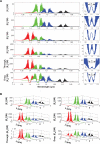Blood cleaner on-chip design for artificial human kidney manipulation
- PMID: 21720507
- PMCID: PMC3124399
- DOI: 10.2147/IJN.S19077
Blood cleaner on-chip design for artificial human kidney manipulation
Abstract
A novel design of a blood cleaner on-chip using an optical waveguide known as a PANDA ring resonator is proposed. By controlling some suitable parameters, the optical vortices (gradient optical fields/wells) can be generated and used to form the trapping tools in the same way as optical tweezers. In operation, the trapping force is formed by the combination between the gradient field and scattering photons by using the intense optical vortices generated within the PANDA ring resonator. This can be used for blood waste trapping and moves dynamically within the blood cleaner on-chip system (artificial kidney), and is performed within the wavelength routers. Finally, the blood quality test is exploited by the external probe before sending to the destination. The advantage of the proposed kidney on-chip system is that the unwanted substances can be trapped and filtered from the artificial kidney, which can be available for blood cleaning applications.
Keywords: blood cleaner; blood dialysis; human kidney manipulation; optical trapping.
Figures





Similar articles
-
Tissue culture system using a PANDA ring resonator and wavelength router for hydroponic plant.IEEE Trans Nanobioscience. 2012 Jun;11(2):119-24. doi: 10.1109/TNB.2012.2189125. Epub 2012 Mar 9. IEEE Trans Nanobioscience. 2012. PMID: 22411055
-
Nanoscopic volume trapping and transportation using a PANDA ring resonator for drug delivery.IEEE Trans Nanobioscience. 2011 Jun;10(2):106-12. doi: 10.1109/TNB.2011.2142421. Epub 2011 Apr 21. IEEE Trans Nanobioscience. 2011. PMID: 21518667
-
Molecular buffer using a PANDA ring resonator for drug delivery use.Int J Nanomedicine. 2011;6:575-80. doi: 10.2147/IJN.S17772. Epub 2011 Mar 22. Int J Nanomedicine. 2011. PMID: 21674014 Free PMC article.
-
Optically-actuated translational and rotational motion at the microscale for microfluidic manipulation and characterization.Lab Chip. 2012 Oct 7;12(19):3624-36. doi: 10.1039/c2lc40538e. Lab Chip. 2012. PMID: 22899251 Review.
-
Review of cell and particle trapping in microfluidic systems.Anal Chim Acta. 2009 Sep 7;649(2):141-57. doi: 10.1016/j.aca.2009.07.017. Epub 2009 Jul 14. Anal Chim Acta. 2009. PMID: 19699390 Review.
Cited by
-
Rapid and cost-effective fabrication of selectively permeable calcium-alginate microfluidic device using "modified" embedded template method.Biomicrofluidics. 2012 Mar;6(1):12821-128219. doi: 10.1063/1.3672189. Epub 2012 Mar 15. Biomicrofluidics. 2012. PMID: 22662088 Free PMC article.
-
Physical Processes in Polymeric Filters Used for Dialysis.Polymers (Basel). 2019 Feb 26;11(3):389. doi: 10.3390/polym11030389. Polymers (Basel). 2019. PMID: 30960373 Free PMC article. Review.
References
-
- Wesson LG. Physiology of human kidney. Grune and Stratton, Inc; New York: 1969. The Jefferson Medical College of Philadelphia Pa.
-
- Manalich A, Reyes L, Herrera M, Melendi C, Fundora I. Relationship between weight at birth and the number and size of renal glomeruli in humans: a histomorphometric study. Kidney Int. 2000;58:770–777. - PubMed
-
- Rashad S, Barsoum MD. Chronic kidney disease in the developing world. N Engl J Med. 2006;354:997–999. - PubMed
-
- Scarpioni R, Ricardi M, Melfa L, Cristinelli L. Dyslipidemia in chronic kidney disease: are statins still indicated in reduction cardiovascular risk in patients on dialysis treatment. Cardiovasc Ther. 2010;28:361–368. - PubMed
Publication types
MeSH terms
LinkOut - more resources
Full Text Sources
Medical

